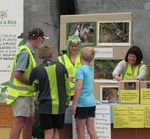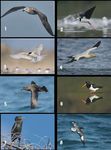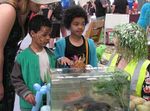Kārearea Protecting a southern land Dec '17-Jan 2018 - Forest and Bird
←
→
Page content transcription
If your browser does not render page correctly, please read the page content below
Kārearea
Protecting a southern land
Dec '17–Jan 2018
Image: Craig McKenzie
Predator Free NZ – what are
the chances? Jane Young
The background time and effort to lugging traps through the bush or
All Forest & Bird members know that it’s necessary to servicing trap lines would have made exclamations of
kill introduced predators. However, those of us who are scorn or disbelief at the announcement of the Predator
less than enthused by endless discussions about the Free NZ project. Their back-of-an-envelope calculations
mechanics of the business probably weren’t too thrilled of the astronomical number of traps required to do the
to discover that the theme of the 2017 South Island job were reinforced by Graeme Elliot’s presentation
Gathering in Murchison was “Predator Free NZ". As it showing a blizzard of red dots superimposed on a map
turned out, the presentations and conversations were of the Paparoa National Park. Even if you could get the
less about different trap designs or the relative merits of funding necessary to buy the traps, the sheer physical
peanut butter and cinnamon lures, and more about the effort required to service them would be a killer.
big-picture stuff and the importance of bringing people
and communities together to take on a challenge which
the late Sir Paul Callaghan described as New Zealand’s
‘Apollo moment’.
DOC Threatened Species Ambassador Nicola Toki set
the scene by describing the genesis of the Predator
Free NZ concept during a two-day meeting at F&B’s
Ruapehu Lodge in 2012, during which scientists and
environmentalists rapidly reached the consensus,
“Yes we can!” However, current methods alone
cannot achieve this goal. There must be investment in
developing new technologies.
Kevin Hackwell showed the dramatic increases in
areas that have been rendered predator free since
early beginnings in the 1950s when a group of school
children poisoned all the rats on tiny Maria Island in the
Hauraki Gulf. (One suspects that the operation mightn’t
have passed muster with present-day health & safety
standards.) Confrontation Jim Young
Predator Free NZ depends on a number of critical At present, like it or not, there is no alternative to the
factors for success. Both national and local governments use of toxins for predator control on a large scale,
need to get on board, and close collaboration at all but “Ban 1080!” signs throughout New Zealand are
levels is essential. Speakers repeatedly stressed the a constant reminder of the extent of public hostility.
need to “bring the community with us.” By and large, It’s good to see that one of the policies of the new
New Zealanders love animals, and can find it hard to government is to research alternative toxins – 1080
understand why conservationists spend so much of is undeniably effective, but is described as only
their time killing them. Nicola made the point that we ‘moderately’ humane, while other toxins may be even
can – and should – respect all life while facing up to the worse from this point of view.
fact that we are forced to kill introduced mammals in Unfortunately facts don’t always (often?) change
order for our native animals to avoid extinction. opinions, but it was still useful to get up-to-date
information about the effectiveness of 1080 that didn’t
The methods
attempt to gloss over the problems. Graeme gave
Many F&B members who devote huge amounts of
Cont p2Predator Free NZ – what are the chances? improve lizard survival, using chimney-style traps
for cats, and protecting individual kea nests. All very
cont from p1 depressing, but at least if you’ve got the data you know
examples from the “Battle for our Birds” project involving whether or not your efforts are worthwhile.
the prediction and monitoring of beech mast events New technology
in which heavy seed fall results in rodent and stoat One thing we do know is that success won’t be
plagues. Without predator control, mohua (yellowhead) achieved by simply doing more of the same. Tom Kay
populations recover to some extent after a plague, but from ZIP (Zero invasive predators) stressed the role
trend steadily downwards. If 1080 is dropped at the that will be played by new technology. This is already
time when the germinating seeds are a good source of coming into play: sensors that detect when a trap has
food for the mice then the consequent stoat population been triggered, motion-activated cameras, automatic
explosions can be averted, but – and there’s always a ‘but’ resetting traps, global positioning for aerial application
– the control of rats isn’t always as effective. of baits etc. (Mind you, some of the research that Tom
By-kill is a constant worry despite the huge amount described wasn’t all that hitech. Ever thought of using a
of research that has gone into making 1080 drops both toy mouse as a lure in a rat trap?)
safer, eg by using lower concentrations per hectare; and Other technologies are more controversial, especially
more effective, eg by pre-feeding so that predators are those involving any form of gene modification. GM
more likely to take the bait. Kea, an endangered species, doesn’t necessarily involve transfers of genes from
is a particular cause for concern. Although 1080 drops one species to another. For example, rats could be
result in higher nesting success, the birds that hang engineered with a gene for sterility and, using a process
around humans hoping called gene drive,
for a free feed (‘junk food made to pass on that
kea') are more likely to gene to all its offspring.
pick up the bait than Sounds good if it
their warier relations. could just be confined
(Bird repellents for use to New Zealand, but
with bait are being what happens if GM
trialled.) Kaka, on the rats end up in other
other hand, don’t eat countries where rats
the bait, and both their are normal members
survival and nesting of ecosystems? A new
success is significantly tool called ‘daisy drive’
improved after 1080 is intended to remove
applications. the risk that the gene
So where are the birds? Field trip at the 2017
Weka are different again. They may eat the bait South Island Gathering in Murchison will ‘escape’, but ….
and become sick for a while but usually survive.
Weka have dagger-like beaks and almost literally nest It is people. It is people. It is people.
with their backs to the wall, so even cats may think People have caused the problem of introduced pests
twice about taking them on. However, when stoat and predators, and only people, working together, can
populations are going through the ‘bust’ phase of a solve it. At present Predator Free NZ is an almost purely
boom and bust cycle, then starving predators may kill aspirational goal, with lots of problems to be ironed out
even the most determined birds. At this stage, the use before it can be implemented. Kevin Hackwell pointed
of 1080 can have a positive effect on both adult and to a failure of leadership to date, coupled with a lack of
chick survival. strategy and overall coordination. And of course it will
The need for evidence all go for nothing if governments aren’t prepared to put
The importance of research came over loud and clear in a lot of money.
during the Gathering. We need to understand more Even if the goal is achievable, there will still be other
about animal behaviour – predators as well as prey. At problems to confront. Predator Free NZ only targets
Lincoln University scientists have set up a stoat enclosure rats, stoats and possums – not mice, cats, ferrets or
so they can study stoat behaviour at low densities. Which hedgehogs. Any Ecology 101 student could predict, for
is the main driver – sex or food? In other studies, scientists example, what will happen to mouse populations – and
hope to find out whether ‘super-lures’ will help to mop up consequently to feral cats – when predation pressure on
the survivors after intensive pest control has been carried the mice is suddenly relaxed by killing rats and stoats.
out. Other investigations aim to determine how close Deer and pigs are other introduced mammals that
together must traps be to provide a buffer zone around a can cause huge damage to native ecosystems but aren’t
predator-free mainland ‘island’. being specifically targeted. In fact we still hear of idiots
And of course there are times when everyone’s deliberately releasing them into the wild. It’s a simple
best efforts just don’t bring about the outcomes that equation: no forest = no forest birds.
you’d hope for. Nick Joyce of DOC described both the There are no magic bullets and no easy solutions.
successes and the failures of the work being done But the South Island Gathering did give Forest & Bird
at Rotoiti near Nelson. Failures included attempts to members cause to hope that maybe, just maybe,
Predator Free NZ does have a chance of success.
2 Dec '17–Jan 2018 KāreareaForest & Bird at the
2017 A&P Show
Sea Bird ID If you missed our competition at
the South Otago A&P Show you can still test your skills
on the birds shown in the photos below. Answers on p6.
South Otago Forest & Bird
Catlins Birds
A pocket guide
t What to see
t Where to see
t How to ID
$10
Proceeds fund local
environmental projects
Birds to choose from:
A Black-backed gull E Gannet
B Black shag F Pied oystercatcher
C Pied stilt G Sooty shearwater More of Craig McKenzie's bird photographs can be
D Cape petrel H White-fronted tern seen in Catlins Birds, available from South Otago
Forest & Bird janejimyoung@slingshot.co.nz.
3 Dec '17–Jan 2018 KāreareaFrom around the country
Myrtle rust has been discovered in Auckland
for the first time. The fungal disease was found to
have affected several hundred ramarama plants at a
commercial nursery in West
Auckland. Myrtle rust has
been relatively dormant
over the winter months but
new infections are likely to
break out as we head into
summer. Susceptible plants
The Beast The Amazon Warrior the world’s largest include kanuka, rata and
seismic blasting ship aka The Beast has entered NZ pohutakawa. A phone app
waters on its way to Taranaki where it plans to seismic has been developed so that
blast for oil right in the middle of blue whale habitat. citizen scientists can help to
Greenpeace NZ is calling on the Prime Minister to monitor the spread of the
stand by her climate-change commitments and stop disease.
http://naturewatch.org.nz /nz/
oil and gas exploration off the Taranaki coast. Forest
projects/myrtle-rust-reporter
& Bird has sent an open letter to the company urging
Ramarama infected
them to abandon their plans. The seismic survey area with myrtle rust MPI
covers 19,000 square km and includes the proposed
Taranaki blue whale sanctuary. It also provides
habitat for the rare pygmy right whale, Shepherd's
beaked whale and the strap-tooth beaked whale.
The Te Kuha coal mine has been
granted consent. Forest & Bird is warning that
the decision by the West Coast Regional and Yellow-eyed penguin crisis The steady
Buller District Councils to allow an approx decline of South Island populations of the
150 ha opencast coal mine on public endangered yellow-eyed penguin (hoiho) has
land – some of it on New Zealand’s continued in 2017. Most worryingly, nearly half
conservation estate – could the breeding population on the island sanctuary
push Great spotted kiwi and other of Whenua Hou (Codfish Island) has disappeared
endangered species such as South at sea. Forest & Bird say the evidence indicates
Island fernbird and the West Coast the birds most likely drowned in commercial
green gecko closer to extinction. Forest & Bird set nets and is calling for an immediate action to
CE Kevin Hague commented: “Everybody eliminate the risks
agrees that this area has high ecological from set netting
values. It’s one of our forgotten places – home in the penguins'
to the largest population feeding areas. Nearly
of our rarest butterfly, but all recorded penguin
languishing in the lowest deaths as bycatch
category of conservation have come from
land. The mining industry boats with observers
claims the economic on board, indicating
benefits outweigh the that many deaths
costs, but in fact these are simply not being
benefits are overstated and reported.
the costs much higher than
suggested."
Great spotted kiwi Rod Morris
4 Dec '17–Jan 2018 KāreareaSouth Otago Forest & Bird in association with The Catlins Historical Society invites you to: The Catlins Summer Programme Jan–Feb 2018 Events may include: • Bat talks & walks at Tahakopa • Birds at the Catlins River estuary • Bushcraft • Fossils at Papatowai • Historical Society bus tour • History, birds & bush at Otanomomo • Insect conservation at Earthlore • Lichens in the Catlins • Local geology at the Owaka Museum • Mohua (yellowheads) at the Wisp • Predator-free projects • Predator tracking at Pounawea • Sea lions at Cannibal & Surat Bays • Walk the Long Track at Lenz Reserve • Yellow-eyed penguin activities For more information: A detailed programme will be available in mid-December at local libraries and i-sites. You will be able to find it on South Otago Forest & Bird’s Facebook page www.facebook.com/ForestAndBirdSouthOtago or by contacting Jim Young at 034158532 janejimyoung@slingshot.co.nz 5 Dec '17–Jan 2018 Kārearea
The Kea 2017 Bird of the Year
'Junk food kea'
Jim Young
Southern Events Contact Details
South Otago Forest & Bird
Sat 9 Dec 1–3pm
www.facebook.com/ForestAndBirdSouthOtago
Te Rere Full Day Penguin Count
Leader Brian Rance Roy Johnstone 03 418 1319 johns-stones@rivernet.co.nz
rances@southlandcommunitynursery.org.nz South Otago KCC
◊ KCC coordinator 0274180044 southotago@kcc.org.nz
Sat 9 Dec 1–3pm Southland KCC Southland Forest & Bird
Beaks and feet and nests Chris Rance 03 213 1161 rances@ihug.co.nz
Southland Community Nursery Education Centre
185 Grant Road Otatara. Southland KCC Bronwyn KCC 2130017
Leader Bronwyn southland@kcc.org.nz The Catlins Bat Project
◊ Catriona Gower 0223 914 698 catlinsbats@gmail.com
Wed 20 December 7.30pm Coal Action Murihiku (CAM)
Southland Forest & Bird (with OLG & Tramping Club) Jenny Campbell 027 351 0180 jennycam@xtra.co.nz
Bushy Point Trig Walk
Leader Barry Smith bjsrdms@gmail.com
Conservation Volunteers Coastal Otago
Meet at 173 Grant Rd Otatara. Bring some supper to share. volunteerscoastalota@doc.govt.nz
◊ Yellow-eyed Penguin Trust
Jan–Feb South Otago Forest & Bird www.yellow-eyedpenguin.org.nz
Catlins Summer Programme New Zealand Sea Lion Trust www.sealiontrust.org.nz
Kārearea: protecting a southern land
Contributions welcome. Copy for Feb 2018 due on 31 Jan.
Answers to Sea bird ID p3 Editor Jane Young: janejimyoung@slingshot.co.nz
1 A 2 C 3 H 4 E
5 G 6 F 7 B 8 D Our thanks to Telford for
sponsoring the printed
version of this newsletter.
6 Dec '17–Jan 2018 KāreareaYou can also read



























































